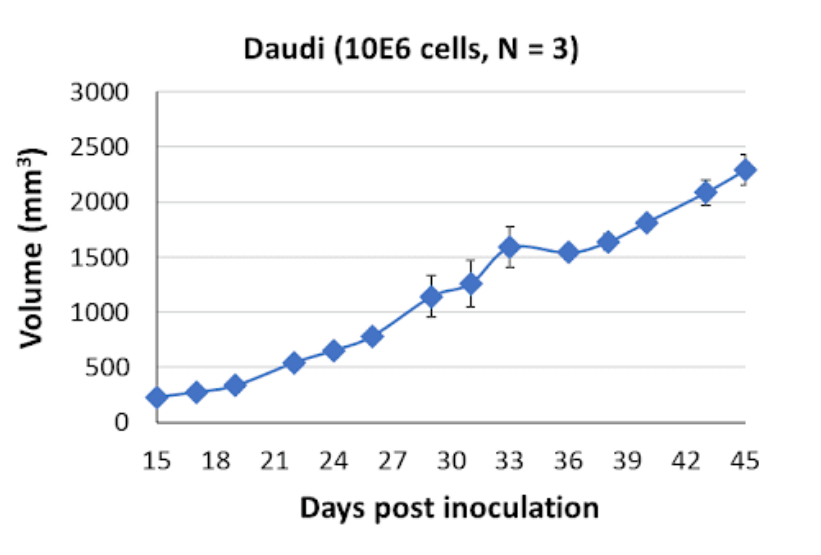About Daudi
The DAUDI cell line, derived from the lymph node of a 16-year-old male diagnosed with Burkitt’s lymphoma in 1966, is a valuable tool for studying B-lymphoblastoid cells and Burkitt’s lymphoma biology. Morphologically, DAUDI cells exhibit characteristics of B lymphocytes and are classified as B-lymphoblastoid cells. These cells secrete immunoglobulin M (IgM) and express surface markers associated with B lymphocytes, such as CD19, CD20, and CD22. The expression of these markers confirms the B-cell lineage and the relevance of DAUDI cells as a model for studying B-cell-related disorders.
A distinguishing feature of the DAUDI cell line is the presence of a c-Myc translocation, specifically the t(8;14)(q24;q32) translocation. This translocation leads to constitutive upregulation of MYC genes, resulting in the overexpression of β-catenin. The dysregulation of β-catenin signaling pathway has been associated with the induction of stemness in cancer cells. Therefore, the DAUDI cell line provides an opportunity to investigate the molecular mechanisms underlying the development and progression of Burkitt’s lymphoma, particularly the role of c-Myc and β-catenin in promoting stemness and tumorigenic potential.
Phamacologically, DAUDI cells have been found to be sensitive to doxorubicin, which is a standard chemotherapy drug used in the treatment of Burkitt’s lymphoma. The sensitivity of DAUDI cells to doxorubicin reflects their clinical relevance and provides a platform to study the mechanisms of drug response and resistance in this specific lymphoma subtype. By investigating the molecular pathways and genetic factors associated with drug sensitivity in DAUDI cells, researchers can gain insights into optimizing treatment strategies and overcoming resistance in Burkitt’s lymphoma patients.
Daudi Tumor Kinetics in the SRG™ Rat

In vivo, xenografts of DAUDI cells in the SRG rat have resulted in the formation of nodular and soft tumors. The nodular morphology suggests the clonal expansion of DAUDI cells in the tumor microenvironment, while the soft consistency of the tumors provides insights into their cellular composition and architectural properties. Investigating the characteristics of DAUDI-derived tumors in the SRG rat model allows researchers to examine tumor growth dynamics, assess therapeutic responses, and explore interactions between tumor cells and the host environment.
Products & Services
Xenograft Efficacy Studies
Includes collection of blood, tissues & tumor for ADME, PK/PD and analysis.
(Bi)weekly Tumor Sampling
Via fine needle aspiration (FNA). For longitudinal evaluation of drug exposure, histology and gene expression.
OncoRats
Cutting edge models optimized for engraftment.
Get help with your research by scheduling a call with Hera.
References (MLA):
- Angi, Meenu, et al. “The T(8;14)(Q24.1;Q32) and Its Variant Translocations: A Study of 34 Cases.” ScienceDirect, 31 Mar. 2017, www.sciencedirect.com/science/article/pii/S165838761730033X?via%3Dihub.
- Blandino, Rebecca, and Nicole Baumgarth. “Secreted IgM: New Tricks for an Old Molecule.” Oxford Academic, Nov. 2019, academic.oup.com/jleukbio/article/106/5/1021/6935669.
- Li, Qian, et al. “Dysregulation of Wnt/β-Catenin Signaling by Protein Kinases in Hepatocellular Carcinoma and Its Therapeutic Application.” Wiley Online Library, Feb. 2021, onlinelibrary.wiley.com/doi/10.1111/cas.14861.
- Xu, Jinhua, et al. “β-Catenin Regulates c-Myc and CDKN1A Expression in Breast Cancer Cells.” Wiley Online Library, Feb. 2015, onlinelibrary.wiley.com/doi/10.1002/mc.22292.

